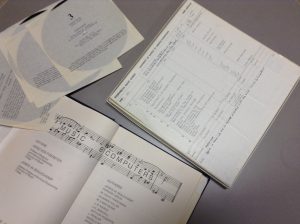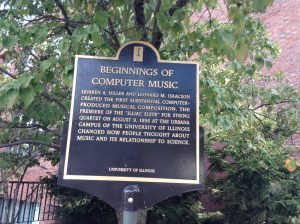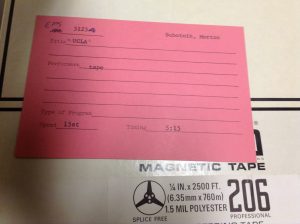
The original master recording for the flexi-discs that accompanied the book Music by computers – Beauchamp & Von Foerster (1969).
Welcome back to the blog!
Since my last entry, the project has advanced considerably…
Last week we had a meeting in the EMS which included the current and former Directors of the EMS (Scott Wyatt and Eli Fieldsteel respectively), Josh Harris (UIUC Preservation Unit), and Scott Schwartz (Sousa Archives and Center for American Music). The meeting was extremely positive and we got a lot accomplished. Among those accomplishments were:
- Scott Schwartz acknowledged that the Sousa Archives and Center for American Music would take much of the materials and add it to their collection. The Sousa already hosts many items from the EMS. Furthermore, by including these items into the Sousa Collection the EMS materials are guaranteed to have a long term preservation plan as well as a disaster plan.
- In talking with Scott Schwartz, we came to an understanding as to the data that should be collected from the materials during the cataloging process. At the moment (with the analog recordings), I am collecting all of the data on the tape cases. I am also doing an item-level evaluation of the physical tapes themselves and detailing condition concerns.
- I talked to Scott Wyatt about the provenance of the recordings and what their original purpose was. Scott confirmed that some of those recordings were indeed “master recordings.”
Sine my last entry, I created a cloud-based survey form that I can easily enter information about the tapes into (and then export that data as an Excel file). This has made collecting data much easier.
I initially made the rookie mistake of trying to both catalog data nd examine publishing information at the same time. I soon realized that it would make a lot more sense to just catalog all the materials and then go back through the data and detail information about the provenance and uniqueness of the materials. This will also be easier with the assistance of the Sousa Archives. That said, I am collecting the data regarding if a tape is a “master” or “copy” of the recording. Any recording masters will, of course, have a high priority for preservation and digitization.
There is, of course, also issues of potential copyright issue regarding the materials in this collection. Scott talked about this quite a bit. Those issues will have to be sorted out in the following rounds of this project. That said, there are certainly master recordings that originated both on and off campus by well-known composers in the EMS’ collection. That in of itself is tremendously exciting.



